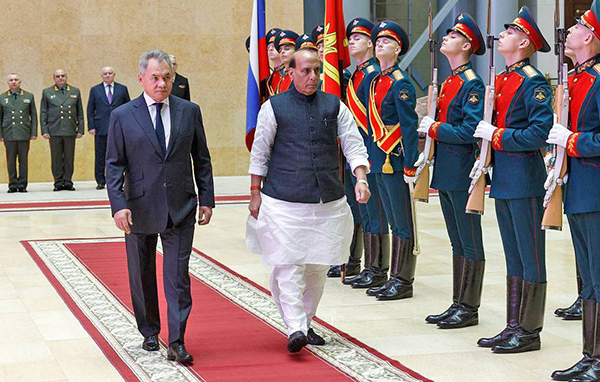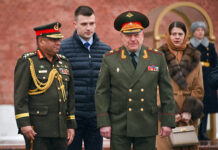
Russia has backed India in the face-off with China along the Line of Actual Control (LAC) in eastern Ladakh. India’s tough stance against China’s aggression along the de facto border in eastern Ladakh has been appreciated by the world powers, including the United States and Japan, who want China to resolve the matter peacefully.
“We are against any unilateral geopolitically motivated actions and illegal extraterritorial sanctions which create instability, mistrust and unpredictability,” Russian Ambassador to India Nikolay Kudashev said, without naming any country. He was speaking at a webinar on ‘Russia-India Relations and Pandemic Test of Global Governance‘ organised by BRICS Russia Expert Council and an Indian think-tank on July 23.
Despite an unprecedented violent clash between Indian and Chinese troops in June, in which India lost 20 of its soldiers, external affairs minister S. Jaishankar took part in a virtual Russia-India-China (RIC) meeting so as to not disrupt the equation with Russia.
BRICS Meet in September
Besides the India-Russia Annual Summit later in 2020, there will be other two major meetings including the Shanghai Cooperation Organisation (SCO) and the Brazil, Russia, India, China South Africa (BRICS) and the national security advisers (NSAs) meetings. Also, the defence ministers of the two countries were expected to meet soon. The dates have not been firmed up.
ALSO READ Russia to deliver Su-30MKIs, MiG-29s to IAF on Fast Track
The Russian ambassador’s remarks came at a time when high-level diplomatic exchanges between the two countries were taking place to finalise the BRICS and SCO agenda. “BRICS was not invented to fight or contain anyone, rather to support the efforts of the international community on the issues related to peace, sustained development and economic cooperation,” said Kudashev.
India’s ambassador in Moscow D. Bala Venkatesh Varma, who also spoke at the webinar, said BRICS had promised to make a difference when it was set up in 2006 but in 2020, when the international situation was complicated, it remained to be seen the informal body lived up to its relevance.
BRICS is an international grouping comprising Brazil, Russia, India, China and South Africa. It was earlier scheduled to meet in St. Petersberg in July but the conclave had to be postponed due to the COVID-19 pandemic.
The BRICS meet is happening at a time when India is laying greater thrust on economic and industrial self-reliance, as it is facing the Chinese aggression.
Russia, which at present heads the BRICS, besides the other key groupings like the Shanghai Cooperation Organisation (SCO) and the Russia-India-China (RIC), too shares similar sentiment like other global powers.
The SCO currently comprises eight member-states China, India, Kazakhstan, Kyrgyzstan, Russia, Pakistan, Tajikistan and Uzbekistan, four observer-states interested in acceding to full membership (Afghanistan, Belarus, Iran, and Mongolia) and six ‘Dialogue Partners‘ (Armenia, Azerbaijan, Cambodia, Nepal, Sri Lanka and Turkey).
Chinese foreign minister Wang Yi will attend both meetings while Pakistan foreign minister Shah Mehmood Qureshi will attend the SCO meet.
20th Anniversary of India-Russia Partnership
2020 marks the 20th anniversary of the India-Russia strategic partnership.
On 4 August, India’s foreign secretary Harsh Vardhan Shringla and Russian deputy foreign minister Igor Morgulov discussed the forthcoming calendar of high-level meetings in the framework of BRICS and SCO and interactions and meetings at various levels preparatory to the India-Russia Summit in October when Russian President Vladimir Putin will visit New Delhi.
An Indian Military Contingent had gone to Moscow to participate in the 75the anniversary of the victory in World War II.
In the last week of June and less than a fortnight after the Galwan Valley clash, defence minister Rajnath had visited Moscow where he met key figures from the Russian military-industrial complex, including defence minister Sergei Shoygu and deputy prime minister Yury Borisov besides the CEOs of Rostec Corporation and Rosoboronexport.
ALSO READ India to urge Russia to rush delivery of S-400 system
Annual Summit
Ahead of the annual India-Russia summit in October 2020, several high level exchanges are scheduled between the officials of both sides. Russian president Vladimir Putin will come accompanied by a high-level delegation. The focus of talks have been on the regional and international issues; also on enhancing the military cooperation as well as expediting the delivery of some platforms India has ordered.
Prime minister Narendra Modi had congratulated Putin on July 12 on his successful national vote on constitutional amendments in Russia.
India-Russia Military Co-operation
India has placed orders worth approximately $7 billion on Russian military platforms after the LAC tensions.
Both India and Russia are keen to further intensify their military relations by implementing contracts worth almost $ 15 billion, and also ink an Inter-Governmental Agreement under which the two sides are expected to go in for development and production of military platforms, spare parts as well, jointly.
Both sides are keen on developing military cooperation, as well as fighting counter terrorism bilaterally.
As has announced last year after the annual summit, both countries have extended the agreement for mutual military and technical cooperation. This has been extended by almost 10 years and will now expire in 2030.
Almost 86 per cent of the platforms and weapons the Indian armed forces use is from Russia, according to a Stimson Center, Washington paper.
The two sides have a contract in place for the S-400 Triumf ‘SA-21 Growler’ long-range surface-to-air missile (SAM) systems. Under the deal which is worth approximately $5.43 billion, Russia will supply five Triumf regimental kits to India for the Indian Air Force (IAF).
Also, there is the upgraded Mikoyan-Gurevich MiG-29UPG ‘Fulcrum-E’ fighter aircraft for various programmes.
There is joint venture between the two sides to manufacture Kamov Ka-226T ‘Hoodlum’ light utility helicopters. And once it takes off around 140 helicopters are expected to be produced locally. And they will be the main light utility helicopters for the Indian Armed Forces.
The Indian Navy will be receiving four Project 11356 Grigorovich-class frigates. Two out of the four are under construction at the Yantar Shipyard (a subsidiary of the United Shipbuilding Corporation). Two will be constructed at the Goa Shipyard Limited.
BrahMos Aerospace is already delivering ground- and sea-launched cruise missiles to both the Indian Army and the Navy. The joint venture with has already successfully developed and tested the air-launched variant of the weapon.
Almost 1,000 of T-90S Bhishma Main Battle Tanks, which have been made in India with the Russian Transfer of Technology are being used by the Indian Army. The production of the 3VBM42 Mango 125mm armour-piercing fin-stabilized discarding sabot (APFSDS) rounds to be used is going on under license.
The Konkurs-M ‘AT-5b Spandrel’ anti-tank guided missiles (ATGMs), is being produced under license by Bharat Dynamics Limited (BDL).
Joint Venture to manufacture AK-203 7.62 mm Assault Rifles for the Indian Armed Forces is in place. Under this venture Kalashnikov AK-203 7.62 mm Assault Rifles 200 series will be manufactured which will fulfill Indian security agencies’ requirement for small arms. An Inter Governmental agreement between the two countries related to the manufacturing of the Kalashnikov rifles is likely to be signed. All issues are believed to have been sorted out.
Joint Exercise
India will participate in the Russian Kavkaz 2020 strategic command-post exercise scheduled for 15-26 September. The exercise comes at a time when the tensions between India and China are growing along the Line of Actual Control in Eastern Ladakh.
A tri-service contingent with 150 Army personnel and from Air Force and Navy will be heading to Astrakhan in Southern Russia for the exercise.
There will be participation from at least 18 countries in KavKaz 2020 including countries from Central Asian Republics who are part of SCO as well as China, Iran, Pakistan and Turkey. China and Pakistan are also invited to participate in KavKaz 2020 as both countries are members of the SCO.
While the countries which have been invited are yet to confirm their participation, according to a top diplomat, Pakistan is likely to participate.
The SCO has been having multilateral drills and has developed Regional Anti-Terrorist Structure (RATS). This structure is regarded as very important in the counterterrorism operations by the member countries and has its headquarters based in Tashkent. Security officials of all the eight countries sit at the RATS Headquarters in Tashkent.
In fight against terrorism, extremism and separatism, RATS plays a very critical role, as it gives a chance to all to test their intelligence gathering and exchange; technology complement mechanisms between the members states of SCO.
Comments
The next 20 years will be challenging for both India and Russia. Ties between New Delhi and Moscow have undergone a sea change in the past decade as India began to tilt more towards the US thereby diversifying its defence purchases and not solely relying on the Russian armaments.
In an effort to give a fresh lease of life to the flagging relationship, Russian President Vladimir Putin is expected to visit India in October this year notwithstanding the ongoing Covid-19 pandemic.
Moscow also played a key role this time between India and China in bringing the temperatures down on both sides. New Delhi sees Moscow’s role in the ongoing unprecedented standoff with China at the western sector of the Line of Actual Control (LAC) to be “very helpful”.
Despite Russia’s own growing bilateral relationship with China, Moscow did not shy away in assuring India with emergency supplies of armaments if matters deteriorated.
India and Russia have also jointly opposed China’s so-called assertion of power through the belt and road initiative (BRI). While Indian continues to oppose the BRI, Russian Foreign Minister Sergei Lavrov did not attend a virtual meeting of the BRI hosted by Chinese Foreign Minister Wang Yi in July.
By promising India with emergency armaments, Moscow “has given a signal to China” that Beijing alone cannot assert power in the region.
Russia has also acknowledged that despite the threat of US sanctions under the Countering America’s Adversaries Through Sanctions Act (CAATSA), India has remained firm on buying the S-400 Triumf air defence missiles system.
All these are signs that India and Russia continue to remain close friends and depend on each other during a crisis situation.


















[…] ALSO READ INDIA-RUSSIA: Military Ties Remain Strong […]